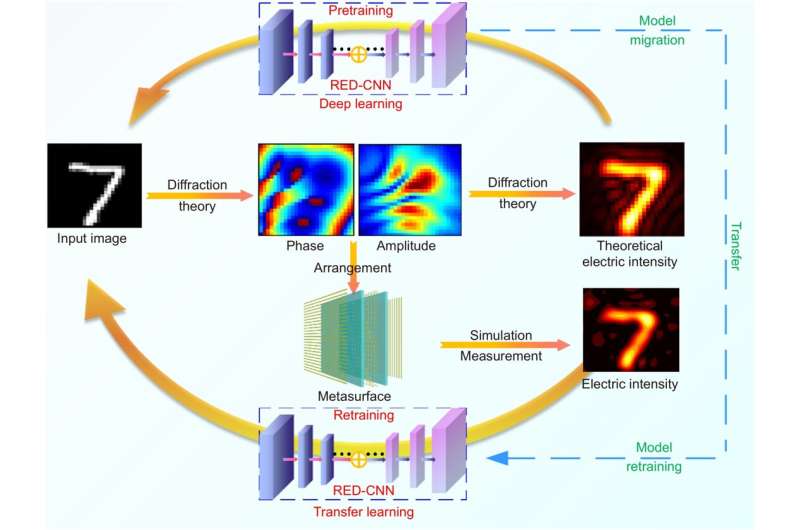This article has been reviewed according to Science X's editorial process and policies. Editors have highlighted the following attributes while ensuring the content's credibility:
fact-checked
proofread
Direct field-to-pattern monolithic design of holographic metasurface

Metasurfaces, as two-dimensional metamaterials, display fascinating ability in electromagnetic (EM) modulation within a sub-wavelength scale, opening up a new way for manipulating the properties of EM wave in a plane. Owing to the flexible modulation of EM wave, metasurfaces have spawned a number of enchanting applications, such as perfect absorbers, cloaking devices, planar meta-lens and meta-hologram.
The emergence of metasurface exhibits extraordinary capabilities in developing and improving optical and microwave devices. Many fascinating works are springing up, which has greatly enriched the design and application of holograms. According to the information modulation mode, metasurface holography can be roughly divided into three categories: phase-only, amplitude-only and complex-amplitude metasurface holography.
In traditional hologram designs, the phase and amplitude distributions of the metasurface are derived based on Huygens-Fresnel theory, and then the target hologram distribution is filled by designing metasurface elements with a specified EM response to complete the design of the metasurface.
However, due to the coupling between elements and the error of elements, the theoretical results of diffraction theory are slightly different from the actual ones. Therefore, further numerical simulation is needed to verify the hologram, which consumes computational resources and increases the complexity of the design.
Therefore, simplifying the traditional design process will further improve the design efficiency of metasurface. The popularization of machine learning in the field of material design provides a new way to simplify the design of metasurface. In recent years, machine learning has been widely used in metasurface design and application.
In metasurface design, the most common design methods are applied at the microstructure level, including forward design and inverse design of metasurface, that is, EM response can be deduced directly from the structure and geometric parameters can be deduced from the EM spectrum.
Machine learning effectively speeds up the design efficiency of metasurfaces by replacing the simulation process. However, traditional methods are mainly concerned with the optimization of the EM response of the cells, and the optimized cells are arranged according to the specified distribution to achieve the specified function, which means that the coupling between the cells is ignored.
Thus, metasurfaces can be designed from a macroscopic perspective. By analyzing the spatial distribution of the local field, the internal law of the local field can be accurately explored and the mapping relationship between the local field and the modulator can be reconstructed. Therefore, the design efficiency and precision of metasurface can be further improved by analyzing the electric field distribution from a macroscopic perspective and monolithically generating metasurface structure through machine learning method.
Complex-amplitude holographic metasurfaces (CAHMs) with the flexibility in modulating phase and amplitude profiles have been used to manipulate the propagation of wavefront with an unprecedented level, leading to higher image-reconstruction quality compared with their natural counterparts.
However, prevailing design methods of CAHMs is based on Huygens-Fresnel theory, meta-atom optimization, numerical simulation, and experimental verification, which results in a consumption of computing resources. Here, the researchers Prof. Wang and Prof. Qu from Air Force Engineering University applied residual encoder-decoder convolutional neural network to directly map the electric field distributions and input images for monolithic metasurface design.
A pretrained network is firstly trained by the electric field distributions calculated by diffraction theory, which is subsequently migrated as transfer learning framework to map the simulated electric field distributions and input images. The training results show that the normalized mean pixel error is about 3% on dataset.
As verification, the metasurface prototypes are fabricated, simulated, and measured. The reconstructed electric field of reverse-engineered metasurface exhibits high similarity to the target electric field, which demonstrates the effectiveness of our design. Encouragingly, this work provides a monolithic field-to-pattern design method for CAHMs, which paves a new route for the direct reconstruction of metasurfaces.
The paper is published in the journal Opto-Electronic Advances.
More information: Ruichao Zhu et al, Direct field-to-pattern monolithic design of holographic metasurface via residual encoder-decoder convolutional neural network, Opto-Electronic Advances (2023). DOI: 10.29026/oea.2023.220148
Provided by Compuscript Ltd





















